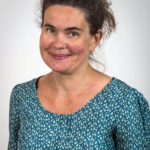Thanks to English economist Kate Raworth, this oily, yet tasty round American pastry has become the symbol of an economy that promotes prosperity within planetary boundaries. The city of Amsterdam was the first to seize the concept, back in 2020, in order to renew its 100% circular city strategy in 2050, in an increasingly integrated approach. Together with a delegation of 20 people representing 10 French local authorities and one Swiss municipality, Sylvie and Blandine from Energy Cities met the municipality of Amsterdam and its local players.
Land of collaboration and compromise
Upon arrival, we quickly understand that the capital of The Netherlands (873,000 inhabitants – 1,700,000 in the metropolitan area), like the entire country, has been able to invent and preserve its land by reclaiming it from the sea thanks to an ingenious system of dikes and pumping. If the country is particularly vulnerable to global warming, compromise and negotiation have punctuated its history. And this is not an anecdote, but it structures the way negotiation happens between stakeholders. And when it comes to donuts, this is very important!
In April 2020, in the midst of a health crisis, the Amsterdam city council declared that it wanted to base its strategy on this economic model to “make the city’s economy fully circular by 2050, starting by halving the use of raw materials in 10 years.”
For this purpose, the city developed its “Donut” portrait, a local version of Kate Raworth’s economic model. The main difficulty was to define the social indicators, which are often very complex to grasp.
The city has also consulted citizens and can rely on the “Amsterdam Donut Coalition”, a network of “change makers” that brings together some twenty neighborhood associations, NGOs, SMEs and universities, which have also taken up the concept to act.
The Donut thus serves as a stimulus for cross-sectoral collaboration, within municipal departments and with all stakeholders in the area.
3 sectors or value chains are concerned:
- food, including stopping waste
- Consumption goods
- The construction sector
For the latter, the city promotes the use of more sustainable materials, such as wood, and has introduced “material passports” that identify each building component to facilitate its subsequent reuse or recycling.
We visited the first circular municipal building in Amsterdam, the “De Vondeltuin” restaurant, located in a beautiful park in the heart of the city. The roof, for example, is covered with wood from old Amsterdam trees and the natural stone walls are made of old curbs. The window frames and toilets come from the demolition of another building…and the concrete used onsite is 50% recycled.
Of course, some rules had to be broken in order to voluntarily implement these principles of action , but “if you’re afraid of everything, you don’t do anything,” summarizes Arno de Wijn, project manager.
The Donut in action at Gaasperdam
Later, in the working class district of Gaasperdam, in the southwest of the city (33,000 inhabitants, 54% of whom live below the poverty line), we discover a very concrete application of the Donut theory. We are welcomed at the Green Hub, where Anne Stijkel and her colleagues from the COCRATOS foundation – International Institute for Inclusive Science – enthusiastically explain how they have seized the Donut to turn it into a social tool, for the benefit of the inhabitants of the district. This is how the concept of Donut Deals was born: it is a set of cooperation agreements between two or more organizations that decided to address together at least 1 theme from the “outside” ring of the Donut (the ecological ceiling) and at least 3 themes from the “inside” (the social base). This is the way organizations, companies and citizens cooperate to carry out local actions for the good of the community and in coherence with the planetary limits.
Among the 8 donut deals realized so far, the team had the chance to visit a mini-digester for the local biogas production. The installation methanizes the food waste coming from the main restaurant in the district. That gives it full energy autonomy thanks to the produced biogas. A side benefit: without food waste in the garbage, the rats disappear from the neighborhood!
Co-designing the city
Our last morning was dedicated to a visit at the creative and social innovation center Pakhuis De Zwijger, located in a rehabilitated wasteland of the old port of Amsterdam.
The director and founder of this inspiring place, Egbert Fransen, explained his vision and his working philosophy: Pakhuis is an NGO, a real creative breeding ground for all urban issues, local democracy and sustainability. Its aim is to sharpen critical thinking through dialogue with all. All year round, five evenings a week, events and meetings are offered free of charge to all inhabitants of Amsterdam. During the day, the spaces are rented out for conferences and other private events, thus guaranteeing the association’s financial independence (out of a budget of 2 million euros, only 500,000 euros of subsidies stem from the municipality). Several staff members are part of the Donut coalition and the NGO has two branches located in the two most disadvantaged neighborhoods of the city for a more inclusive public participation.

« Thank you for this study tour proposed and wisely prepared by Energy Cities. It allows us to take a step back, to share and learn from inspiring approaches, to network…and ultimately to come back and adapt solutions and projects to the realities of our territories. Sharing makes our policies grow and progress! »

« This trip allowed us both to get very close to the concrete implementation of the donut theory as well as to exchange in the group on our experiences around the circular economy. It opens new perspectives for the crucial transformation of our communities. »
This study trip has been made possible thanks to funding from ADEME.
You may also be interested in reading our (French) study on sufficiency strategies in Europe.

